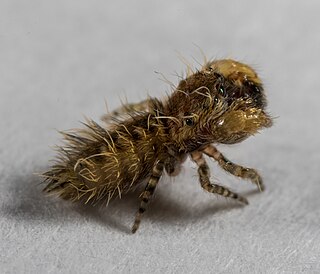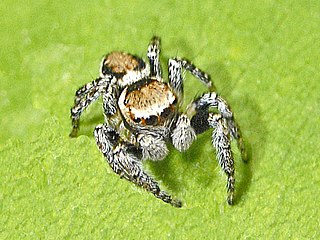
Jumping spiders are a group of spiders that constitute the family Salticidae. As of 2019, this family contained over 600 described genera and over 6,000 described species, making it the largest family of spiders at 13% of all species. Jumping spiders have some of the best vision among arthropods and use it in courtship, hunting, and navigation. Although they normally move unobtrusively and fairly slowly, most species are capable of very agile jumps, notably when hunting, but sometimes in response to sudden threats or crossing long gaps. Both their book lungs and tracheal system are well-developed, and they use both systems. Jumping spiders are generally recognized by their eye pattern. All jumping spiders have four pairs of eyes, with the anterior median pair being particularly large.

Phidippus audax, the bold jumper or bold jumping spider, is a common species of spider belonging to the genus Phidippus, a group of jumping spiders easily identified by their large eyes and their iridescent chelicerae. Like all jumping spiders, they have excellent stereoscopic vision that aids them in stalking prey and facilitates visual communication with potential mates during courting. Bold jumping spiders are native to North America and have been introduced to Hawaii, Nicobar Islands, Azores, and the Netherlands. They are typically black with a distinct white triangle on their abdomen.

Cyrba is a genus of spiders in the family Salticidae. The genus was erected by Hippolyte Lucas in 1846.
Eburneana is a genus of the spider family Salticidae.

Margaromma is a spider genus of the jumping spider family, Salticidae. The eight described species occur mostly in Australia and New Zealand, with several other species on Pacific islands. One species is found in Cameroon.

Uroballus is a spider genus of the jumping spider family, Salticidae. It includes seven accepted species.

Zygoballus is a genus of jumping spiders found in North and South America.

The anatomy of spiders includes many characteristics shared with other arachnids. These characteristics include bodies divided into two tagmata, eight jointed legs, no wings or antennae, the presence of chelicerae and pedipalps, simple eyes, and an exoskeleton, which is periodically shed.

Evarcha falcata is a species of 'jumping spiders' belonging to the family Salticidae.

Maevia inclemens or the Dimorphic Jumping Spider is a relatively common and colorful jumping spider of North America. In the males there are two forms, a very rare phenomenon in zoology. These use different courting displays, and differ in appearance: the "tufted" morph has a black body and pedipalps ("palps"), three black tufts across its "head", and pale legs; and the "gray" morph has black and white stripes all over its body and legs, orange palps, and no tufts. However, each form accounts for 50% of the adult males, and they are equally successful in mating. A female of Maevia inclemens is 6.5 to 8.0 millimetres long, while males are 4.75 to 6.50 millimetres long.

Bagheera kiplingi is a species of jumping spider found in Central America, including Mexico, Costa Rica, and Guatemala. It is the type species of the genus Bagheera, which includes three other species, including B. prosper. B. kiplingi is notable for its peculiar diet, which is mostly herbivorous. No other known species of omnivorous spider has such a markedly herbivorous diet.

Zygoballus sexpunctatus is a species of jumping spider which occurs in the southeastern United States where it can be found in a variety of grassy habitats. Adult spiders measure between 3 and 4.5 mm in length. The cephalothorax and abdomen are bronze to black in color, with reddish brown or yellowish legs. The male has distinctive enlarged chelicerae and front femora. Like many jumping spiders, Z. sexpunctatus males exhibit ritualized courtship and agonistic behavior.

Zygoballus nervosus is a species of jumping spider which occurs in the eastern United States and Canada.
Habronattus fallax is a species of spiders from the family Salticidae found in the United States and Mexico.

Trite auricoma, commonly known as the golden-brown jumping spider, is a species of jumping spider endemic to New Zealand.

Stenaelurillus guttatus, synonym Mashonarus guttatus, is a species of jumping spider in the genus Stenaelurillus that lives in Botswana, Zambia and Zimbabwe. It was first described in 2002 by Wanda Wesołowska and Meg S. Cumming. It was initially the type species for the genus Mashonarus but was moved to its current genus in 2018. The spider is medium-sized, with a cephalothorax that is between 2.1 and 2.7 mm long and 2.0 mm (0.079 in) and an abdomen that is between 2.3 and 3.8 mm long. It is very dark in colour, either dark brown or black, and has a distinctive pattern on its back consisting of two white stripes on the thorax and three sets of two white patches on the abdomen. This pattern gives the species its name, which is based on a Latin word that can be translated spotted. It lives in a wide range of environments, from dry to wet climates, and at altitudes between 500 and 1,500 m above sea level. First observed in a garden, the spider has been found under logs, stones and rocks, in leaf litter, and, after rains, on grass, shrubs and garden walls. It feeds on termites, particularly Odontotermes transvaalensis, and other prey including fruit flies and leafhoppers.

Phintella pygmaea is an endemic species of jumping spider in the genus Phintella that lives in China. It was first described in 1981 by Wanda Wesołowska from a holotype discovered in Guangdong. Only the female has been described. The spider is small, with a brown cephalothorax and yellow abdomen. It has distinctive half-crescent markings on the cephalothorax and a ridge marked by two depressions on the small epigyne.

Phintella caledoniensis is a species of jumping spider in the genus Phintella that lives in New Caledonia. First described in 2009 by Barbara Patoleta, it was named after the island where it was found. The spider is small and has a brown cephalothorax with patches, the female being generally darker, and a grey or grey-brown abdomen. The female has distinctive bean-shaped spermatheca and the male a long and thin embolus.

Eris militaris, known commonly as the bronze jumper or bronze lake jumper, is a species of jumping spider, belonging to the Salticidae family. It is found in the United States and Canada within both suburban and rural areas. The male and female of this species can be differentiated from their size or by the coloration on their cephalothorax and abdomen. The females have a lighter cephalothorax a slightly darker abdomen with white spots. They are active in the autumn and winter season and can be found in sheltered areas within vegetation. They can also be found living within apple orchards, where insecticides may be present, which can potentially effect or alter their personality and behavior. Their diet consists of small insects, almost anything they can hold.

Carrhotus viduus is a species of spider in the family Salticidae. It is found in South and Southeast Asia. It is the type species of the genus Carrhotus.


















